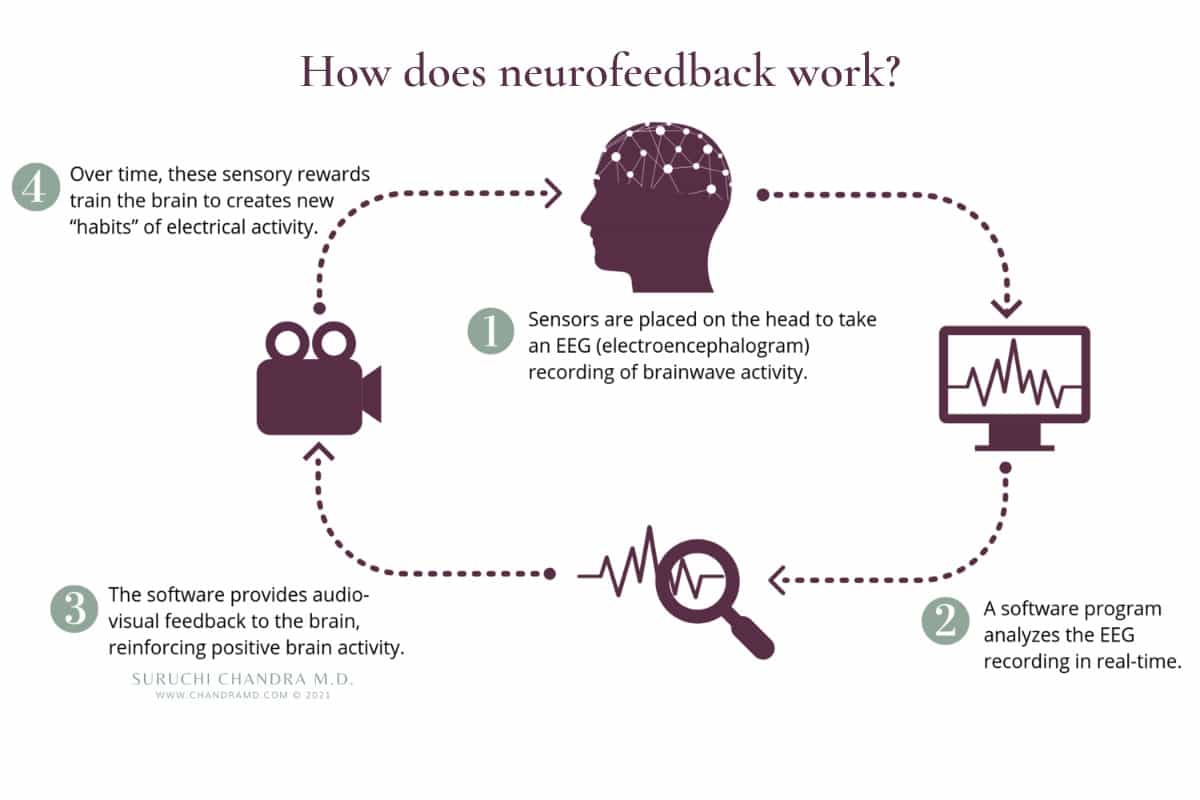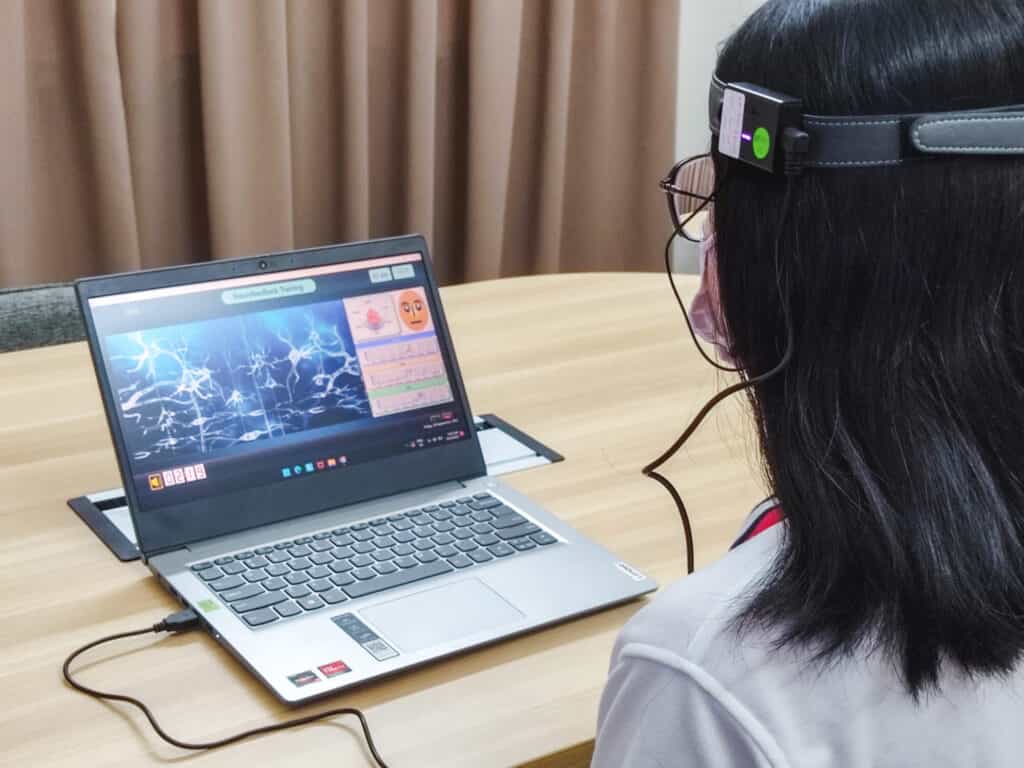Neurofeedback, also known as biofeedback-EEG, is a non-invasive method that doesn’t involve medication to intervene in brain conditions in humans, especially in children with developmental disorders such as Attention Deficit Hyperactivity Disorder (ADHD), Attention Deficit Disorder (ADD), Autism Spectrum Disorder (ASD), and other neurological disorders.
Some questions arise:
– What is neurofeedback?
– How does it work?
– Is neurofeedback really effective?
– What can it treat?
– Is it safe? Are there any side effects?
Neurofeedback is a non-invasive treatment method. When the brain is properly stimulated, it has the ability to change and adapt due to its neuroplasticity. Neurofeedback allows us to communicate with the brain using its own language, which is BRAIN WAVES.
WHAT ARE BRAIN WAVES?
.jpg)
Neurofeedback works by monitoring brain waves through electrodes placed on the scalp. These electrodes detect the electrical activity generated by neurons communicating with each other. The brain waves are then displayed visually or audibly to the individual receiving the treatment.
During a neurofeedback session, the individual is presented with real-time feedback of their brain wave patterns. Through various exercises and tasks, they learn to control these patterns. For example, they may be asked to increase the amplitude of specific brain waves associated with relaxation or decrease the frequency of waves associated with stress or anxiety.
Through repetition and reinforcement, the brain learns to self-regulate and produce more desirable patterns of brain wave activity. Over time, this can lead to improvements in symptoms associated with various mental health disorders.
Neurofeedback sessions are typically conducted over multiple sessions, and the specific protocol may vary depending on the individual’s needs and the goals of the treatment. The process is often customized based on the individual’s unique brain wave patterns and symptoms.
Overall, neurofeedback aims to help individuals regulate and normalize disrupted brain wave patterns associated with mental health disorders, leading to improvements in symptoms and overall well-being.

Feedback and neural response, also known as biofeedback – EEG, is a non-invasive method that doesn’t involve medication to intervene in human brain conditions, especially in individuals with developmental disorders, including Attention Deficit Hyperactivity Disorder (ADHD), Attention Deficit Disorder (ADD), Autism Spectrum Disorder (ASD), and other neurological disorders.
Some questions arise:
What is neural feedback?
How does it work?
Is neural feedback really effective?
What can it treat?
Is it safe? Are there any side effects?
Neural feedback is a non-invasive treatment method. When the brain is properly stimulated, it has the ability to change and adapt due to the nervous system’s plasticity. Neural feedback allows us to communicate with the brain using its own language, which is BRAIN WAVES.
WHAT ARE BRAIN WAVES?
Brain cells communicate through electrical impulses called brain waves. Each brain wave has two characteristics:
1. Frequency: This is the speed of wave propagation.
2. Amplitude: This is the height of the wave when it goes up and down.
Fast brain waves are associated with concentration, thinking, and perception;
Slow brain waves are associated with relaxation, meditation, and deep sleep.
In mental health disorders, brain wave patterns can be disrupted, leading to unhealthy behaviors and biological activities.
For example, individuals with anxiety disorders may have excessive fast brain wave activity, making them feel restless, agitated, and fearful. On the other hand, those with ADHD may have excessive slow brain wave activity, resulting in symptoms such as brain fog, daydreaming, and difficulty concentrating.
The goal of neural feedback therapy is to help regulate these disrupted brain wave patterns.
HOW DOES NEUROFEEDBACK WORK?
Neurofeedback works by measuring brain wave activity through electrodes placed on the patient’s scalp to measure real-time brain wave activity (known as electroencephalography or EEG). Once set up, the patient can watch a movie, play video games, or listen to music as the neurofeedback training process begins. When the EEG detects that the patient’s brain wave activity has responded to the treatment goals, the brain receives positive feedback. The brain produces more slower alpha waves and fewer faster beta waves.
Repetition of training. EEG continues to monitor the patient’s brain waves and provides positive feedback when treatment goals are met. This iterative training loop provides the brain thousands of opportunities to adjust appropriately, gradually enhancing brain activity.
Training the brain through positive feedback based on the principles of learning theory or operant conditioning.
Neural feedback intervention is not affected by any electrical currents or brain stimulation like some other brain-based therapies (e.g., TMS, LENS, or tDCS).
In summary, our brains use brain waves to communicate and function. These brain waves can be disrupted, leading to mental or neurological symptoms. Neural feedback is a non-invasive treatment method aimed at addressing the imbalance in brain wave activity to help patients heal more deeply and function better.
WHAT CAN NEUROFEEDBACK TREAT?
Because brain waves are involved in all brain activities and functions, this treatment method can be used for various neurological conditions.
1. Mental Health:
This includes disorders such as OCD (Obsessive-Compulsive Disorder), PTSD (Post-Traumatic Stress Disorder), and other mental disorders. Neural feedback can help patients feel calmer and safer.
For example, treating anxiety disorders may involve reducing excessive fast beta waves (associated with anxiety) and increasing alpha waves (associated with calmness).
2. Developmental Delay & Behavioral Disorders:
Including Autism Spectrum Disorder (ASD), Attention Deficit Hyperactivity Disorder (ADHD), Attention Deficit Disorder (ADD), Intellectual Disabilities (ID), Learning Disabilities (LD).
For developmental disorders, the brain does not develop proper communication networks, especially in children with autism. Neural feedback can significantly alter nerve connections as detected by fMRI imaging and improve aberrant behaviors.
3. Neurological Issues and Brain Injuries:
Including individuals who have had encephalitis, stroke, Parkinson’s disease, etc.
For these conditions, neural feedback offers hope for new treatment avenues, especially when combined with an integrated approach with conventional medicine.
4. Enhancing Brain Function:
This includes athletes, executives, and students aiming for excellence.
Neural feedback is like exercise for the brain and can help even those without mental or neurological disorders achieve optimal function.
DIFFERENT TYPES OF NEURAL FEEDBACK:
Neural feedback is a general term referring to various types of biofeedback EEG systems. The different types depend on the type of brain waves trained, therapeutic goals, and the number of targeted brain regions.
The most common types of neural feedback are:
1. Amplitude Training: Focuses on increasing or decreasing the rhythm of certain brain waves. Training slow brain waves (ILF, ISF, and SCP), the slowest brain waves, may help regulate and control emotions.
2. Z-Score Training: Adjusts brain wave activity to the normal level of healthy individuals.
DOES NEUROFEEDBACK WORK?
Asking whether neural feedback works is similar to asking whether medication is effective.
The results depend on the suitability for the patient’s condition or the ability of treatment to change the patient’s brain biology. Some individuals may not benefit from neural feedback because they do not use the system suitable for their needs.
Most clinical doctors in this field use neural feedback because they have seen it work and improve patients’ conditions when applied correctly. Imaging (i.e., fMRI) shows that treatment has indeed changed the structure and function of patients’ brains.
IS NEUROFEEDBACK SAFE?
Neural feedback is a non-invasive treatment method, a form of brain exercise, so it is considered safe, with minimal side effects. The most common side effects include: drowsiness, lack of focus, mild headaches, and anxiety. In an evaluation of patients with ADD/ADHD, these side effects occurred in only about 1-3% of patients.
It is important for patients to report side effects to their clinical doctor so they can adjust the treatment approach. As long as appropriate adjustments are made and you are working with a licensed and qualified mental health professional, there will be no long-term symptoms or consequences.
- WHAT TO EXPECT FROM NEUROFEEDBACK TRAINING?

Changes in the brain typically occur gradually and over time. For this reason, it may take multiple sessions to achieve long-term changes in symptoms and brain function. Like all forms of exercise and therapy, it’s best to train neurofeedback on a regular schedule, typically 2-3 times a week.
To determine treatment response: Most systems may take from 10 to 20 sessions. Slow wave training systems (i.e., ILF, ISF, and SCP) may take 1-5 sessions.
To reinforce long-term benefits: 30-40 sessions. For more complex conditions such as autism, other developmental delays, and brain injuries, more sessions may be needed.
WHY CHOOSE NEUROFEEDBACK?
By directly targeting specific locations in the brain and altering the brain’s biology to function better, Neurofeedback has the potential to provide long-term benefits and heal the brain in new ways.
While this field still requires more research to help us understand the exact mechanisms behind the nervous system’s plasticity and EEG biofeedback, it’s a promising treatment option when done correctly. Hopefully, neurofeedback will be seen as a serious treatment option by both clinicians and patients alike.








